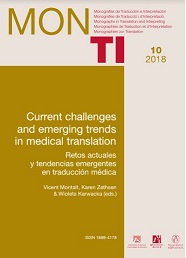Informed consent translation and communication as a tool to ensure its comprehensibility
Main Article Content
Abstract
Downloads
Article Details
The documents contained in these directories are included by the contributing authors as a means to ensure timely dissemination of scholarly and technical work on a non-commercial basis. It is understood that all persons copying this information will adhere to the terms and constraints invoked by each author's copyright. These works may not be reposted without the explicit permission of the copyright holder.
References
Cambridge, Jan. (2002) “Interlocutor roles and the pressures on interpreters.” En: Valero Garcés, Carmen & Guzmán Mancho Barés (eds.) 2002. Traducción e Interpretación en los Servicios Públicos. Nuevas necesidades para nuevas realidades. Community interpreting and translating: new needs for new realities. Madrid: Servicio de Publicaciones de la Universidad de Alcalá, pp. 11-124.
Campos Andrés, Olga. (2013) “Procedimientos de desterminologización: traducción y redacción de guías para pacientes.” Panacea 14:37, pp. 48-52. COEM. (2016) Decálogo del consentimiento informado. Versión electrónica: http://www.cgcom.es/noticias/2016/06/16_06_21_decalogo_consentimiento_informado
Crezee, Ineke. (2013) Introduction to healthcare for interpreters and translators. Amsterdam: John Benjamins Publishing Company.
Epstein, Ronald; Peter Franks; Kevin Fiscella; Cleveland Shields; Sean Meldrum; Richard Kravitz & Paul Duberstein. (2005) “Measuring patient-centered communication in patient-physician consultations.” Theoretical and Practical issues. Social Science and Medicine 61, pp. 1516-1528.
Gallego Borghini, Lorenzo. (2015) La traducción inglés-español del consentimiento informado en investigación clínica. Barcelona: Fundación Dr. Antonio Esteve.
García Izquierdo, Isabel & Vicent Montalt i Resurrecció. (2013) “Equigeneric and Intergeneric Translation in Patient-Centred Care.” Hermes Journal of Language and Communication in Business 51, pp. 39-51.
Gil-Alberdi González, Beatriz. (2009) “El redactor de textos médicos como professional independiente.” En: Rico-Villademoros, Fernando & Vicente Alfaro (eds.) 2009. La redacción médica como profesión: Qué es y qué hace el redactor de textos médicos. Barcelona: Fundación Dr. Antonio Esteve.
Leanza, Yvan. (2005) “Roles of community interpreters in pediatrics as seen by interpreters, physicians and researchers.” Interpreting. International journal of research and practice in interpreting 7:2, pp. 167-192. Amsterdam: John Benjamins Publishing Company.
Longacre, Margaret; Thomas Galloway; Claudia Parvata & Carolyn Fang. (2015) “Medical communication-related informational need and resource preferences among family caregivers for head and neck cancer patients.” Journal of Cancer education 30:4, pp. 786-791.
Mayor Serrano, Blanca. (2005) “Análisis contrastivo (inglés-español) de la classe de texto folleto de salud e implicaciones didácticas para la formación de traductores médicos.” Panacea 6:20, pp. 132-141.
Mayor Serrano, Blanca. (2008) Cómo elaborar folletos de salud destinados a los Pacientes. Barcelona: Fundación Dr. Antonio Esteve.
Mazzi, María Ángela et al. (2016) “How patients would like to improve Medical consultations: insights from a multicentre European study.” Patient Education and Counselling 99:1, pp. 51-60.
Meyer, Ingrid & Kristen Mackintosh. (2000) “When terms move into our everyday lives: an overview of determinologization.” Terminology 6:1, pp. 111-138.
Montalt i Resurrecció, Vicent & Isabel García Izquierdo. (2016) “¿Informar o comunicar? Algunos temas emergentes en comunicación para pacientes.” Panacea 27:44, pp. 81-84. Versión electrónica: http://www.tremedica.org/panacea/IndiceGeneral/n44_editorial.pdf
Montalt i Resurrecció, Vicent & María González Davies. (2007) Medical Translation Step by Step. Manchester: St Jerome.
Muñoz Miquel, Ana. (2012) “From the original article to the summary for patients: Reformulation procedures in intralingual translation.” Linguistica Antverpiensia, New Series Themes in Translation Studies 11, pp. 187-206. Versión electrónica: http://repositori.uji.es/xmlui/bitstream/handle/10234/79290/56678.pdf?sequence=1&isAllowed=y
Muñoz Miquel, Ana. (2014) “El perfil y las competencias del traductor medico desde el punto de vista de los profesionales: una aproximación cualitativa.” Trans 18, pp. 163-181. Versión electrónica: http://www.trans.uma.es/Trans_18/Trans18_163-181_art2.pdf
Nord, Christiane. (2012) “Quo vadis, functional translatology?” Target 24:1, pp. 26-42.
Ordovás Baines, Juan Pablo et al. (1999) “Análisis de las hojas de información al paciente para la obtención de su consentimiento informado en ensayos clínicos.” Medicina Clínica 112:3, pp. 90-94.
Plaut, Victoria & Robert Bartlett. (2012) “Blind consent? A social psychological investigation of non-readership of click-through agreements.” Pubmed 36:4, pp. 293-311.
Prieto Velasco, Juan Antonio. (2014) Representación gráfica de conceptos médicos: estudio de caso de la guía para pacientes Efectos secundarios del Taxol® (paclitaxel). Universidad Jaume I, Castellón. Trabajo de fin de master.
Saiz Hontangas, Paula et al. (2016) “El uso de imágenes en guías para pacientes: una primera aproximación desde la perspectiva del nivel de activación del paciente.” Panacea 17:44, pp. 99-110. Versión electrónica: http://www.tremedica.org/panacea/IndiceGeneral/n44_tribuna-PSaiz-HontangasEtAl.pdf
Sánchez Martos, Jesús. (2014) “La educación para la salud y las habilidades de comunicación ante los avances de la medicina personalizada.” En: Sánchez Caro, Javier & Fernando Abellán (eds.) 2014. Medicina personalizada. Aspectos científicos, bioéticos y jurídicos. Madrid: Fundación salud 2000, pp. 96-112.
Soujanen, Tytti; Kaisa Koskinen & Tiina Touminen. (2015) User-centered translation. New York: Routlegde.
Toledo Chavarri, Ana et al. (2016) “El papel de la documentación escita en el empoderamiento en salud: un estudio cualitativo.” Panacea 17:44, pp. 115-122. Versión electrónica: http://www.tremedica.org/panacea/IndiceGeneral/n44_tribuna-AToledo-ChavarriEtAl.pdf
Valentini, Miriam et al. (2013) “Application of a readability score in informed consent forms for clinical studies.” Journal of Clinical Research and Bioethics 4:3, pp. 156-161.
Valero Garcés, Carmen. (2011) “Estudio para determinar el tipo y calidad de la comunicación lingüística con la población extranjera en los Centros de salud.” En: El impacto de la inmigración en la población autóctona. Madrid: OFRIM, pp. 118-132.
Villamañán, Elena et al. (2016) “El consentimiento informado en investigación clínica, ¿entienden los pacientes lo que firman?” Farmacia hospitalaria 40:3, pp. 210-215. Versión electrónica: http://dx.doi.org/10.7399/fh.2016.40.3.10411
Wolfer, Sascha. (2015) “Comprehension and comprehensibility.” En: Maksymski, Karyn; Silke Gutermuth & Silvia Hansen-Schirra (eds.) 2015. Translation and Comprehensibility: Arbeiten zur Theorie und Praxis des Übersetzens und Dolmetschens, vol. 72. Berlín: Frank & Timme, pp. 22-52.


